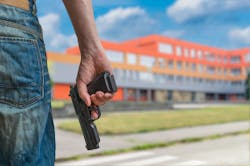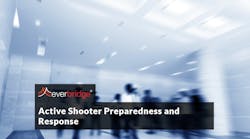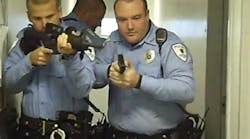Every time it happens, we are shocked. Stunned. Saddened. Every time it happens, our hearts go out to victims and their loved ones. The “it” to which I refer is, unfortunately, a school shooting. Each is a tragic event that should have been prevented.
According to FBI reporting, a total of 60 active shooter incidents have occurred between 2000 and 2019. Of those, 44 incidents occurred in schools serving children from Pre-K to 12th grade, while 16 others were on a higher-ed campus. While it is incomprehensible to think that someone can take a weapon into a school and shoot innocent children and/or young adults, solving this growing problem will be anything but simple. It is a complicated, societal issue that will require compromise on several hot-button issues, and, unfortunately, the resolution appears to be nowhere in sight.This article will focus on mitigation strategies should anyone find themselves in an active shooter incident, as well as school safety measures that should be in place to prepare to prevent injury or death. The overall goal is that every individual can understand their options and the risks. Schools must maintain a best-in-class approach to developing and implementing an active shooter mitigation plan/training program that includes regular, various drills and provides self-study materials for students, teachers and administrators because all of us need to be able to answer the question, “Do I know what to do?” before anything happens.
What Can We Do?
Initially, school leadership, from the school administration to the school board, should design and implement a strategic plan, defining the goals and objectives of an Active Shooter Mitigation Plan across the school district. Each school within the district shall be held accountable for meeting the defined metrics that are noted within the plan. Periodic reporting of the results of the plan shall be done to the school board in a scorecard approach.
In addition, each teacher in the school district shall be afforded specific, independent training to increase their knowledge base. This training should prepare staff with the options and subsequent risks should an active shooter incident occur, in support of both the students which they lead and themselves. And lastly, each student shall receive appropriate level training pertaining to their grade or year of education to increase their individual knowledge base so they too can react appropriately to an incident.
The program developed by the school district needs to be consistently applied across the schools in the district and the school calendar shall reflect specific training dates throughout the school year. The plan shall be reviewed each year, with results, and shall be applied year after year throughout the school district. Think fire drills, and for those of us that may remember fallout shelter drills. The active-shooter drills shall identify specific metrics to discern knowledge of “what to do” on the part of the participants to track progress.
School safety and security also include a baseline of security infrastructure; the security game plan which is driven by a school site security assessment. his assessment will consider the current security infrastructure, location and environs of the school, and any incidents affecting the area. Once the assessment is completed, recommendations may be developed to adjust the current level of security infrastructure at the school. These recommendations may include camera/CCTV coverage and/or monitoring, access control to the school, visitor management, intruder system alerts, emergency notification system usage, intercoms, blue lights in parking areas, duress alarms, designing and implementing an active shooter mitigation plan which may include training with local police departments and onsite police presence.
How to Plan for Active Shooters
Next, let’s discuss some of the more important tenets to be incorporated into an active shooter mitigation plan for schools. The ability to identify or detect when there is a problem at the school in a timely manner is tantamount to ensuring a quick and appropriate response by both the school and the authorities. A review of the security infrastructure which may be in place to assist with that detection capability should be made, as well as the process in place to receive any reporting from faculty or students. Once notified, the details provided will assist in the appropriate response by the school, whether through the use of an emergency notification system, word of mouth, or other means, to the students and teachers of the staff’s proposed action to be taken by everyone in the facility. The action may include a lockout if the threat is outside of the school building, or a run/hide/fight scenario should the threat be determined to be inside the school.
While there is nothing safe about being in an active shooter incident, there are some considerations and actions that follow which may make students and staff safer. First and foremost, stay as calm as you can to help an orderly response that will ensure instructions and procedures are followed. Consider the following process:
- Once you become aware of an active shooter incident, assess the situation, and consider your options, i.e., run, hide, fight, that may be available to you.
- Consider the risks which may be associated with each option.
- Determine your individual risk assessment and risk tolerance aligned with each option
- Then act. Realize that there may not be a perfect solution. Take the steps/actions necessary to make yourself safer.
- You may have to reassess your initial decision, and possibly change your course of action during the incident.
- Should you decide to run or flee, you have decided not to remain in the “hot site,” the area in which the active shooter is present. Be aware that the risk when you depart the premises is you may encounter the shooter.
- Leave the premises entirely and don’t wait around to see what is going to happen next.
- Should you decide to hide or shelter, you have decided to remain in the “hot site.” If safe to do so, please find a shelter location to get out of the line of sight of the shooter.
- If you are in a room, attempt to secure the entryway with furniture or lay flat with your feet against the door, if safe to do so.
- If available, close the shades, lock the door, turn off the lights.
- If possible, ensure you have a way to communicate or receive information (news, e-mails, texts, etc.).
- Decide on an exit strategy should exigent circumstances present themselves.
- Control the noise level in the room.
- Place all devices on silent or vibrate mode.
- Continue to gather information/intelligence about what is happening around you.
- Please understand the difference between “cover” and “concealment.”
- Specifically, cover is the protection, generally, from the fire of weapons.
- Concealment is the protection from being seen and does not generally protect you from the fire of weapons.
- If you are in a room, and should someone knock on your door, be aware of the risks associated with the three possible responses:
o Ignore the knock. Risk: Should you take no action, you have not, in all likelihood, given away your position.
o If you provide verbal acknowledgment. Risk: You have given away your position, and, in all likelihood increased your risk exposure.
o If you should open the door. Risk: You have increased your risk exposure to all in the room and possibly allowed the shooter to gain access to the room
The following are general training notes to be considered:
- Which action/option you chose is typically not dependent upon direction from afar. The decision is yours to make.
- Use your best judgment, assessing what information is available at the time.
- Do whatever you have to do to survive.
- The shooter is not like you nor in the same mental state. Please be extremely cautious about approaching him/her.
Note: Source, FBI-A Study of Active Shooter Incidents in the United States Between 2000 and 2013, FBI-Active Shooter Incidents in the United States in 2014 and 2015, FBI-Active Shooter Incidents in the United States in 2016 and 2017, FBI-Active Shooter Incidents in the United States in 2018, and FBI-Active Shooter Incidents in the United States in 2019.
About the author: Brian W. Lynch is the Executive Director for Safety & Security at RANE. Lynch brings nearly four decades of senior management and executive-level experience in the fields of law enforcement, safety, and security. Previously, Lynch served as Head of Global Security at Vanguard. He designed and executed the firm’s enterprise-wide Eight Phase Global Security Program which included the design and execution of the firm’s secure mail operations processes and training, as well as a 24x7 global operational model responsible for the identification, analysis, response, and resolution of security incidents. Lynch was also a Special Agent with the FBI, serving in investigative and senior executive-level positions, over a 22+ year career.







